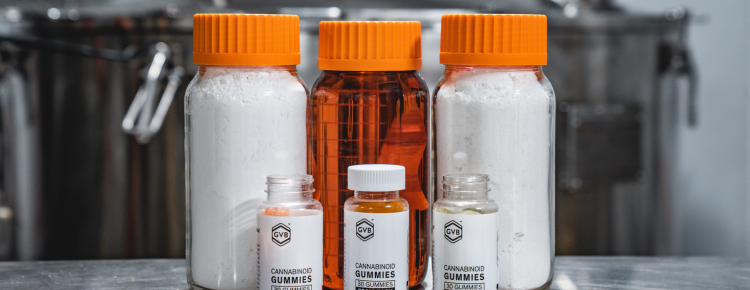Proper product testing is of paramount importance in the CBD industry Companies that choose to pursue proper testing protocols inevitably reap the greatest rewards, but new data from Leafreport¹ reveals that a surprisingly small number of CBD producers comprehensively test their products².
Why is CBD product testing so important, and how should the CBD industry respond to its systemic lack of testing rigor? Learn the latest information and discover pragmatic solutions in this guide.
What is CBD product testing?
Since the inception of the modern CBD industry, third-party product testing has been a key tool for expressing product quality to both consumers and regulators³. Though the FDA has not established testing protocols for the CBD industry, following proper testing procedures proactively is understood to be a reasonable policy in anticipation of eventual industry-wide standardization.
In the absence of such testing standardization, third-party lab testing is the only tool at a consumer’s disposal to determine the safety and purity of a CBD product they are considering using. Over the years, consumer awareness of the importance of CBD product testing has risen to the extent that lab reports now serve a marketing purpose that’s just as important as their furtherance of transparency. CBD product lab tests should provide information on the constituent components of the hemp extract and also provide parts-per-million (PPM) information for various common contaminants. Especially due to the hemp plants’ ability to bioaccumulate possible contaminants from soil, total transparency regarding contamination in CBD products is absolutely vital⁴.
Why is CBD product testing important?
CBD product testing provides consumers with assurance that the CBD products they use are safe and provides brands with a key tool for relaying the benefits of their CBD products to consumers. Especially in the absence of meaningful federal regulation of the CBD industry, lab testing is essentially the only mechanism in place to ensure that contaminated products are detected and prevented from entering the CBD supply.
Product testing also provides the overall CBD industry with a level of legitimacy that it would otherwise have difficulty projecting. By conducting proper lab testing, CBD companies prove that they are “on the level” and that their products do not contain detectable levels of THC. Without comprehensive lab testing, CBD users are left in the dark, and the industry itself loses legitimacy.
Areas CBD tests must cover
Due to the nature of the hemp plant, CBD product testing is complex and must cover a variety of different factors. To start, it is important that CBD products fall within 10% of their stated potency. Lab tests must also accurately represent the concentrations of common contaminants they contain, including microbes, heavy metals, and pesticides.
Here is a look at each area in more detail:
Potency
The amount of CBD a product contains is known as its potency. If the total size of a CBD tincture, for instance, is 1000mg and it contains 800mg CBD, its potency is 80%.
The potency information in a CBD lab report should not only pertain to CBD, however. Just as vital is information regarding the concentration of THC in the product, which must remain below 0.3% to be in compliance with the 2018 Farm Bill⁵.
Depending on the product, it may also be relevant to relay the concentrations of minor cannabinoids and terpenes present. The role terpenes play in the benefits of hemp products is not being actively explored, and consumers increasingly demand information about the terpenes in their CBD products.
Microbial content
During maturation, hemp is relatively prone to fungal and bacterial infections and may be contaminated with microbes during harvesting and extraction. The onus is on CBD producers to prove they properly prevented microbial contamination while making their products.
Heavy metals
Heavy metal contamination in soil leads to product contamination in a variety of industries, but it is especially prevalent in the CBD industry due to hemp’s bioaccumulative properties. During maturation, hemp draws everything in the surrounding soil into itself — even harmful contaminants like heavy metals. To prove they pursued cultivation processes that prevented contamination, CBD companies must show that their products do not contain any traces of these heavy metals.
Pesticides
Even organic hemp products can become contaminated with pesticides used in neighboring agricultural operations. Carried by air or water runoff, pesticides can enter hemp roots and contaminate flowers, making it essential for hemp brands to provide sufficient evidence that their products are pesticide-free.
The latest data from Leafreport
What Leafreport has to say about the current status of testing in the CBD industry is not particularly positive. In great crisis, there is also great opportunity, though, and by learning about the ways CBD testing currently falls short, we can make sure the industry takes a better approach in the future. At GVB, we strive for excellence in our product quality, testing multiple times throughout the production process to ensure we are producing the highest quality ingredients and finished products on the market.
Leafreport’s opening paragraph states that “transparency within the CBD industry appears to be stagnating and deteriorating in several critical respects.” Slightly further in, the report goes on to say that “CBD purity testing for three main contaminants… is still conducted at very low rates across the board” and that “the number of brands with products that measure beyond acceptable potency variance levels is rising.”
We’ll get into what all this means below.
Methods
To produce its report, Leafreport analyzed 4,384 products made by 188 different CBD brands. Leafreport conducted its own tests of each product and compared them to the tests provided by the producer. A full list of the criteria Leafreport tested includes:
– The percentage of products tested for potency
– The percentage of products that tested within 10% of their stated potency range
– The percentage of products tested for pesticides
– The percentage of products tested for heavy metals
– The percentage of products tested for microbes
Key findings
Here’s a summary of the results of Leafreport’s massive, industry-wide analysis:
– 20% of brands do not test their products for pesticides, heavy metals, or microbes
– 28% of brands did not test for pesticides
– 26% did not test for heavy metals
– 24% did not test for microbes
– Only 7% of brands tested for all three contaminants
– 42% of brands test the potency of almost all their products
– Only 12% of brands had all their products test within 10% of the stated potency
– 88% of brands had at least one product that tested outside the acceptable potency variance
– Two brands did not provide any test results whatsoever
Analysis
In some ways, Leafreport’s new 2022 data has improved over 2021’s analysis. Twenty-five percent of brands failed to provide purity testing in 2021, representing a 5% year-over-year decrease. The percentage of brands that test for all three common contaminant types also improved by one percentile point.
In other areas, however, testing within the CBD industry worsened. 84% of brands had at least one product that tested outside the acceptable potency variance in 2021, for instance, marking a trend of four percentile points in the wrong direction in 2022.
Leafreport summarizes its data thusly: “Compared with our 2021 analysis, brand commitment to potency, purity testing, and ensuring acceptable levels of potency variance appears to be floundering.” Even if brands are weary of a continuing lack of comprehensive federal guidance on CBD, the only option is to stay the course and place further emphasis on industry standardization and preemptive compliance.
To conclude, Leafreport turns to two major executives in the CBD space, Papa & Barkley’s Guy Rocourt and Green Roads’ Laura Fuentes. Both concur that the CBD industry is engaged in a “race to the bottom” in which “many brands who only do the bare minimum that is required by law.”
The answer, Fuentes says, is not necessarily further regulation. “[T]he best way consumers can protect themselves is by choosing reputable CBD brands.”
Choose your CBD products wisely
The message that CBD consumers should take out of Leafreport’s 2022 data is that it is more important than ever before to choose your CBD products with an abundance of caution. While the trajectory of the CBD industry appeared firmly pointed at ever-greater professionalism and rigor a few years ago, something within the industry’s culture has seemingly soured.
It is not too late to put things straight. The best members of the CBD manufacturing community can now take it upon themselves to set a standard for compliance and testing that makes it impossible for brands that do not take testing seriously to compete.
Continue calling for rigorous testing
The best way to ensure a better future for CBD product testing is to continue raising awareness about the importance of testing and the vital role it must play in the consumer decision-making process. The more CBD consumers know they should only purchase safe, tested products, the more that disreputable brands will either be forced to adopt proper testing standards or go out of business.
Rising testing standards are not the only facet of the CBD industry that has recently stagnated — everywhere throughout the world of cannabis and hemp, stakeholders are feeling the squeeze as global economic conditions tighten and geopolitical projections destabilize. True leaders in the CBD industry are now presented with an opportunity to lead a consolidated industry into a future of greater standardization, improved product quality, and even more widespread acceptance.
State of testing in the CBD industry: FAQs
1. How are CBD products tested?
CBD products are usually tested using chromatography, a method that involves separating and measuring components in a mixture. A variety of chromatography methods can be used with CBD products, and each lab has its own proprietary approach to the process. Contact a specific lab if you have questions about their testing methodology.
2. Does CBD have to be tested?
While there is no legal requirement for CBD products to be tested at the federal level, it has become the sign of a high-quality and trustworthy CBD product if it is accompanied by a verifiable lab report. In the absence of meaningful federal regulations that would otherwise ensure quality within the CBD industry, shoppers must rely on tools like lab tests to determine if the CBD products they use are safe and effective.
3. How do you tell if CBD is high-quality?
Since federal regulations regarding CBD are still lacking, it remains a case that lab reports are the most effective tools you can use when determining the quality of a CBD product. Always ask if you have any questions about the lab reports a company provides for its products.
Sources
- 1. Evans, D. G. (2020). Medical fraud, mislabeling, contamination: all common in CBD products. Missouri Medicine, 117(5), 394. Retrieved from https://www.ncbi.nlm.nih.gov/pmc/articles/PMC7723146/
- 2. Stone, E. F. (2022, October 16). CBD Market Transparency Report: Only 7% of Brands Test for Pesticides, Heavy Metals and Microbes. https://www.leafreport.com/education/cbd-market-transparency-report-only-7-of-brands-test-for-pesticides-heavy-metals-and-microbes-16349
- 3. Blebea, N. M., Costache, T., & Negres, S. (2019). The qualitative and quantitative analysis of CBD in hemp oils by UHPLC with PDA and applications. Animal Science, 72(1). Retrieved from http://animalsciencejournal.usamv.ro/pdf/2019/issue_1/Art20.pdf
- 4. Rheay, H. T., Omondi, E. C., & Brewer, C. E. (2021). Potential of hemp (Cannabis sativa L.) for paired phytoremediation and bioenergy production. GCB Bioenergy, 13(4), 525-536. Retrieved from https://onlinelibrary.wiley.com/doi/full/10.1111/gcbb.12782
- 5. Abernethy, A. (2019). Hemp Production and the 2018 Farm Bill. US Food and Drug Administration. Retrieved from https://www.agriculture.senate.gov/imo/media/doc/Testimony_Abernethy%2007.25.19.pdf







